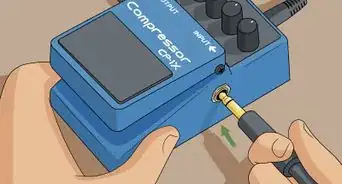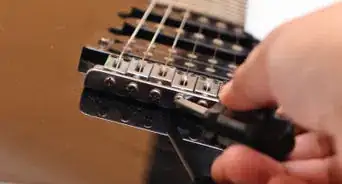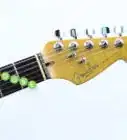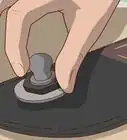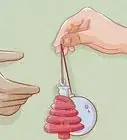This article was co-authored by Aaron Asghari. Aaron Asghari is a Professional Guitarist and the lead guitarist of The Ghost Next Door. He received his degree in Guitar Performance from the Guitar Institute of Technology program in Los Angeles. In addition to writing and performing with The Ghost Next Door, he is the founder and primary guitar instructor of Asghari Guitar Lessons.
This article has been viewed 102,451 times.
If you’re a guitar lover, you might be out for a unique look as well as your own sound. You might also be interested to learn more about how guitars are put together and function. If you have moderate woodworking skills, you can build your own solid-body electric guitar. To make things easier, you can even purchase some parts pre-made. Use your creativity for the finishing touches, and you’ll have a unique guitar and a story to tell.
Steps
Planning Your Instrument
-
1Design your guitar body shape. Before you begin, you’ll want a solid idea of what you want your instrument to look like. You can draw inspiration from a classic model like a Fender Telecaster or a Gibson SG, or make your own unique design. Once you’ve settled on a design, draw the body, full scale, on paper, and cut it out.[1]
- The guitar body shape can be rounded, like a Gibson Les Paul or a Fender Stratocaster, or angled, like a Gibson Explorer or Flying V.
- You can also choose a unique shape for your guitar, such as a square or circle.
- Some guitarists prefer a single cutaway to access the higher frets, some like a double cutaway, or you might choose not to have a cutaway at all.
-
2Choose your materials. Many electric guitar bodies are made of swamp ash, alder, mahogany, or maple. Common woods for guitar necks include maple and mahogany. Rosewood or maple are standard choices for fingerboards.[2]
- Some of these woods are rare or protected, and hard to come by. You can experiment making an electric guitar with any kind of wood you would like, however.
- There is room for variation in terms of the thickness of an electric guitar body. Select a wood size based on the thickness of an existing guitar, or on what feels comfortable to you.
- Each kind of wood has its own tonal quality that makes a unique sound. Woods that are dense and heavy, like walnut or mahogany, have a tone that's thicker and more base-heavy. On the other hand, lighter woods, like basswood or alder, have a tinny, brighter sound.[3]
Advertisement -
3Purchase the required hardware. There’s a lot of variety in terms of the looks and capabilities of the parts you’ll need for your guitar. You can choose based on the kind that existing guitars you like use, or experiment with something new. You can easily buy the equipment you’ll need from most guitar shops or online. For an electric guitar, you’ll need:[4]
- One or more pickups (single coil or humbuckers)
- A bridge
- Tuning pegs
- A nut
- Volume and tone controls and knobs
- A pickup selector switch
- An input for a ¼ inch cable
- A pickguard (optional)
- Strap pegs (optional, but recommended)
- A truss rod (optional, but recommended)
- Fret wire (if you are building your own neck)
- Strings
-
4Buy a pre-manufactured neck. Unless you have a lot of skill and experience in woodworking, it is recommended that you buy a pre-made neck. Since the neck is often considered the most complicated part to make, you might consider purchasing one and building the rest of the guitar yourself. You still do the rest of the work yourself.[5]
-
5Make sure you have the necessary tools and know-how. If you purchase a pre-manufactured neck, building an electric guitar doesn’t require highly sophisticated tools or expertise, but the process isn’t exactly beginner level, either. You’ll need to know how to saw, drill, sand, and solder, and have tools capable of fulfilling these tasks.[6]
- It’s possible to create an electric guitar using hand tools alone. However, having access to an electric jigsaw, drill press, and router will make things much easier and faster.
-
6Buy a kit if you want to make things easier. Several companies produce electric guitar kits that include all of the parts you’ll need, prepared and ready to assemble. If you just want to get your feet wet, these can be a good choice. While you won’t get the full experience of making a guitar from scratch, you’ll still get the satisfaction of putting it together and finishing it yourself.[7]
Shaping the Guitar
-
1Cut the body blank. Lay the cut-out of your guitar body design on the wood you selected, and trace the design onto it. Use a jigsaw (or another saw) to cut through the wood, following the outline you drew.[8]
- Sand the sides of the body blank after cutting it out. If you would like to round off the top and bottom edges of the guitar, use a sander for that as well.
-
2Mark the position of all the body hardware. Draw a line down the center of the body blank for reference. Then, draw marks on the body blank to identify where you want hardware like volume controls and the pickups to go.[9]
- You can position things like volume and tone controls, the pickup selector, and the plug input more or less wherever you like. Follow the design of an existing guitar, or choose what feels comfortable to you.
- Pickups should sit under the strings, centered with the fretboard. Mark the position of the pickups by referencing the center line you drew.
- The bridge needs to be positioned so that the distance between it and the nut on the neck correspond to the scale length of the neck, which varies somewhat depending on the guitar. If you purchased a pre-manufactured neck, use its scale length to position the bridge accordingly. Otherwise, most guitars have scale lengths ranging from 24-26 inches.
-
3Route the body. You’ll need to make a cavity (a hole that goes partly through the body of the guitar) in the back of the guitar to fit the electronics for the volume, tone, pickup selection controls. You will cover it later with a bit of material (usually hard plastic). You’ll also need one cavity in the front of the guitar for each of its pickups. Rout the pickup cavity (or cavities) to the depth recommended by the manufacturer.[10]
- You will also want to rout a cavity where the neck will attach to the body that is wide enough and deep enough to secure the parts together.
-
4Drill holes for the electronics. Use the marks you made earlier as a guide. The number and position of the holes you’ll need will depend on the exact hardware you’re using. Generally, however, you will need holes:[11]
- For the bridge hardware
- For the volume, tone, and pickup selector controls
- To allow the pickup wires to pass from the front cavity to the back one
- To fit the cord input in place
- For the strap pegs (if you are using them)
-
5Paint or finish the body. Much of the creativity that comes from making your own guitar shows in the way the body looks, so use your imagination here. The possibilities are endless! You might try:[12]
- An oil finish to give your guitar a natural look
- A colorful paint and either a high-gloss or matte finish
- Multiple colors to create a striking pattern
- Painting an image or design on the body for a standout look
-
6Cut the neck, if needed. If you purchased a pre-manufactured neck (recommended), skip this step. If not, you’ll need to cut the guitar neck to the width and thickness you prefer. Leave the headstock end wider to accommodate the tuning pegs. Round off the back of the neck (using a belt sander, for instance) until it has a comfortable profile.[13]
- Neck widths are usually about 1.5–1.75 inches (3.8–4.4 cm) at the nut, and widen slightly as the frets get higher.
- Make the headstock whatever contour you like.
- Routing a hole through the length of the neck to insert a truss rod is recommended, but not required.
- If you are adding a fingerboard to your neck, cut a thin piece of wood to the same width as the neck, and glue it on top. Round the edges of the fingerboard to give it a “radius.”
- Cut fret wire to size for each fret, then gently tap the frets in place, then file their edges smooth. Measurements need to be highly precise, so use a spacing template (available online).[14]
- Glue the nut where the fingerboard meets the headstock.
- Attach the tuning pegs to the headstock, drilling holes if necessary.
-
7Bolt or laminate the neck to the body. Attach the neck to the body where you previously made a cavity for this purpose. You can glue the neck in, or run bolts through the back of the body and the neck to fix it in place.[15]
-
8Attach the bridge to the body. There are a number of types of bridges, so the exact directions for attaching yours will depend on its design. The simplest varieties, however, simply require a few screws to fix the bridge in place.
Installing the Electronics
-
1Drop the electronics into place. Run the pickup wires through the holes you previously drilled. Drop the pickups into the cavities on the front of the guitar body, and fix them into place with the screws provided by the manufacturer. Do the same for the volume, tone, and pickup selector controls, as well as the input for the guitar cord.[16]
-
2Solder the electronics. The pickups you purchased should come with a schematic that shows exactly how to connect these to the controls and to the input for the guitar cord. Follow this schematic, using an ordinary electronics soldering iron to complete the job. Wrap any wiring connections with electrical tape, unless the manufacturer’s instructions suggest another method.
- Once the electronics are in, cut a piece of hard plastic to cover the cavity you created in the back of the guitar body. Fix it in place with small screws.
-
3String your guitar and test it. Use your favorite string gauge. After they’re in place, try playing your guitar a bit unplugged to make sure everything feels right. Then, plug your guitar in and play. If all has gone well, the guitar is done![17]
- You might need to make small adjustments to perfect the guitar's intonation, such as changing the bridge pins or saddle height. If you need help doing this, take your guitar to a local shop.
Community Q&A
-
QuestionDo I need much money for this?
 Community AnswerYou can get kits to transform an acoustic guitar to electric for $50 (£30) or buy a full set for around $125 (£105), but it all depends on the type of parts you're using.
Community AnswerYou can get kits to transform an acoustic guitar to electric for $50 (£30) or buy a full set for around $125 (£105), but it all depends on the type of parts you're using. -
QuestionHow thick does the wood for the body need to be?
 Espinoza ChristianCommunity AnswerIt is solely dependent on your preferences as well as the type of wood. But for a design like the common Fender Stratocaster, it should be about 1 and 12/16". If you are designing something like a Les Paul it should be closer to 1 and 7/8", but the Les Paul requires an extremely careful hand due to the curvature and styling.
Espinoza ChristianCommunity AnswerIt is solely dependent on your preferences as well as the type of wood. But for a design like the common Fender Stratocaster, it should be about 1 and 12/16". If you are designing something like a Les Paul it should be closer to 1 and 7/8", but the Les Paul requires an extremely careful hand due to the curvature and styling. -
QuestionCan you show schematics for how to wire the guitar?
 Rudy TothCommunity AnswerYou don't need a schematic to wire a guitar. First, find the hole that you are placing in a new string at the "Bridge" where the silver dot pick ups are located. Run the tip of the string through the hole gently pull the string until no more comes out slide the string through the hole on the neck give some slack too where you think its good enough. Wind that string up and place the string under the first coil turn, so that it has a better grip make sure it fits in the slot plastic part near the bottom of the neck groove. Bring out your guitar "tuner" and tune it up.
Rudy TothCommunity AnswerYou don't need a schematic to wire a guitar. First, find the hole that you are placing in a new string at the "Bridge" where the silver dot pick ups are located. Run the tip of the string through the hole gently pull the string until no more comes out slide the string through the hole on the neck give some slack too where you think its good enough. Wind that string up and place the string under the first coil turn, so that it has a better grip make sure it fits in the slot plastic part near the bottom of the neck groove. Bring out your guitar "tuner" and tune it up.
References
- ↑ https://blog.udemy.com/how-to-make-a-guitar/
- ↑ https://www.stringjoy.com/guitar-wood-guide-tonewoods-guitar-building/
- ↑ Aaron Asghari. Professional Guitarist and Instructor. Personal interview. 15 February 2019.
- ↑ https://blog.udemy.com/how-to-make-a-guitar/
- ↑ https://blog.udemy.com/how-to-make-a-guitar/
- ↑ https://blog.udemy.com/how-to-make-a-guitar/
- ↑ https://blog.udemy.com/how-to-make-a-guitar/
- ↑ https://blog.udemy.com/how-to-make-a-guitar/
- ↑ https://canadianwoodworking.com/project/build-an-electric-guitar-without-the-fancy-tools/
- ↑ https://canadianwoodworking.com/project/build-an-electric-guitar-without-the-fancy-tools/
- ↑ https://canadianwoodworking.com/project/build-an-electric-guitar-without-the-fancy-tools/
- ↑ https://blog.udemy.com/how-to-make-a-guitar/
- ↑ https://canadianwoodworking.com/project/build-an-electric-guitar-without-the-fancy-tools/
- ↑ https://canadianwoodworking.com/project/build-an-electric-guitar-without-the-fancy-tools/
- ↑ https://blog.udemy.com/how-to-make-a-guitar/
- ↑ https://blog.udemy.com/how-to-make-a-guitar/
- ↑ https://blog.udemy.com/how-to-make-a-guitar/
About This Article
To build an electric guitar, start by cutting out the guitar body from a piece of wood like maple or swamp ash. Then, bolt a pre-made neck onto the body and attach the bridge. Next, install the pick-ups, volume control, and guitar cord. Finish by putting your strings on the guitar and testing out your instrument. If you want to make the process easier, you could try purchasing an electric guitar kit. To get some design ideas for your electric guitar, keep reading!



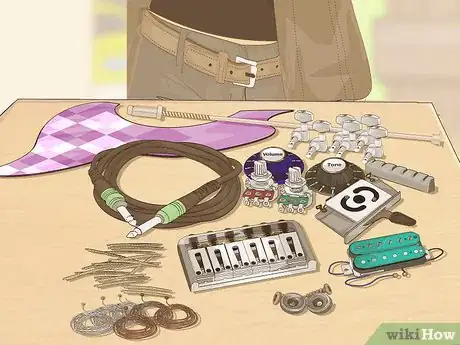

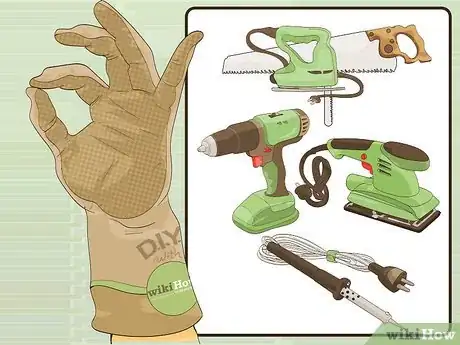

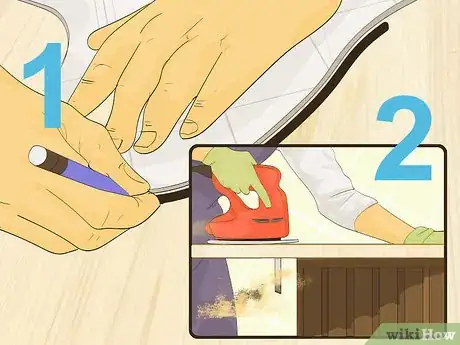
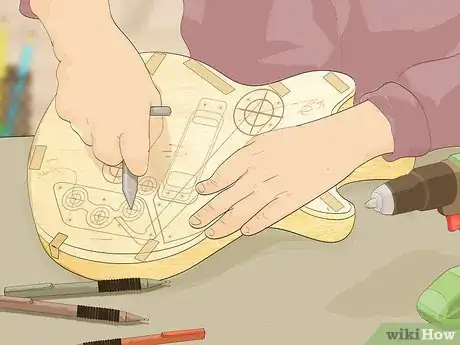
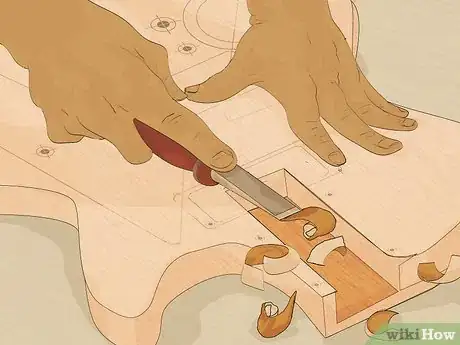
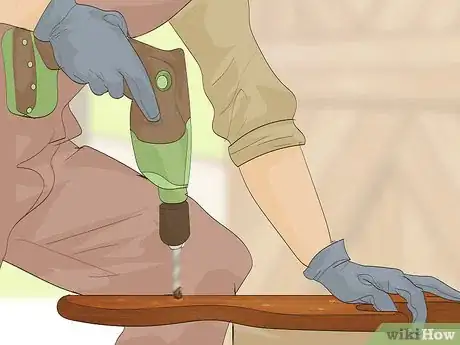
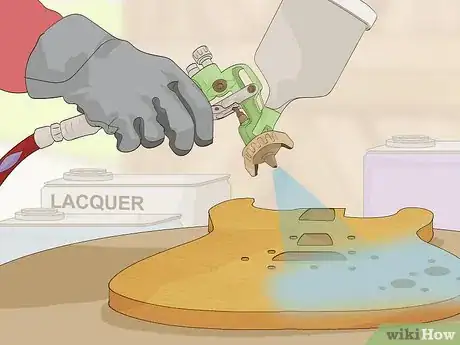
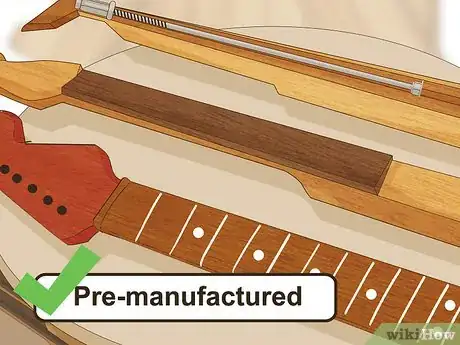
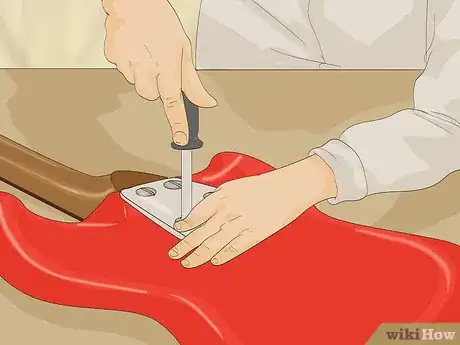
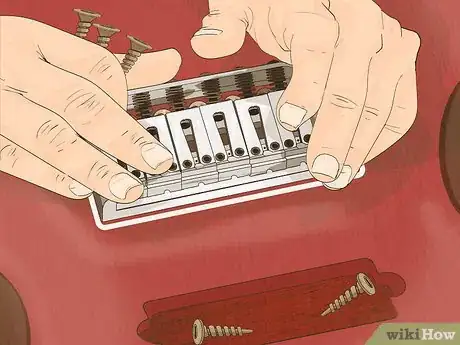
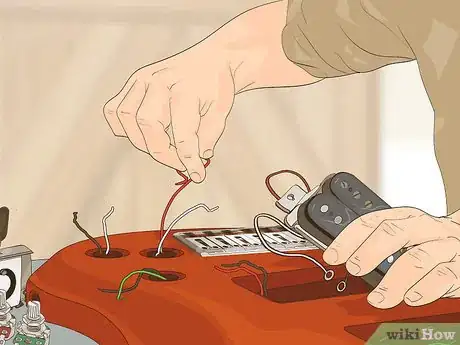
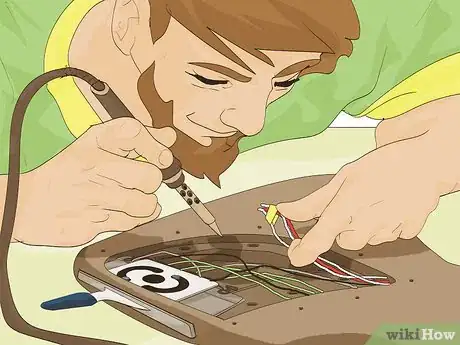




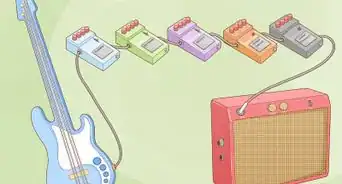

-Step-19-Version-2.webp)
